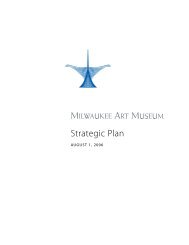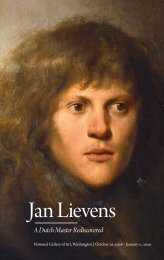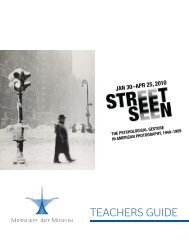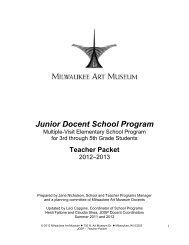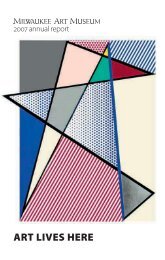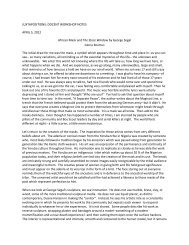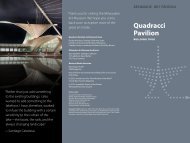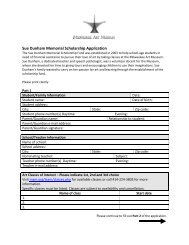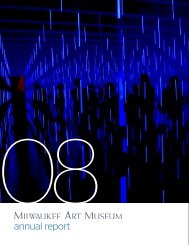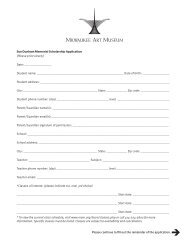Junior Docent School Program - Milwaukee Art Museum
Junior Docent School Program - Milwaukee Art Museum
Junior Docent School Program - Milwaukee Art Museum
Create successful ePaper yourself
Turn your PDF publications into a flip-book with our unique Google optimized e-Paper software.
Year 2 (4 th grade): People, Culture, and History<br />
Theme: Connect<br />
Three tours:<br />
Portraiture<br />
o Students explore types of portraiture and learn how to analyze a portrait<br />
using the elements of art, depicted imagery, and historical and cultural<br />
context.<br />
Wisconsin History<br />
o Students investigate Wisconsin history through works of art.<br />
World Communities<br />
o Students investigate western (European and American) and non-western<br />
(Haitian, Asian, and African) art depicting and/or representing everyday<br />
life.<br />
Tour: Portraiture<br />
Background<br />
The definition of a portrait for this tour is a work of art that represents or symbolizes a<br />
specific person, a group of people, or an animal. Portraits can be executed in any<br />
medium and in either a two-dimensional or three-dimensional format. Portraits usually<br />
show what a person or animal looks like as well as revealing something about the<br />
subject‟s personality. A portrait often tells us about what was important to society at the<br />
time it was made; much of what we know about people who lived before the 1850s is<br />
available to us only through portraits.<br />
Portraits can include only the head of the subject, or they can depict the shoulders and<br />
head, the upper torso, or an entire figure shown either seated or standing. Portraits can<br />
show individuals either self-consciously posing in ways that convey a sense of<br />
timelessness or captured in the midst of work or daily activity. During some historical<br />
periods, portraits were severe and emphasized authority, and during other periods<br />
artists worked to communicate spontaneity and the sensation of life.<br />
Objectives<br />
<br />
<br />
<br />
<br />
Students will be able to identify portraits and discuss the different ways in which<br />
a person, a group of people, or an animal can be portrayed in two-dimensional<br />
and three-dimensional formats.<br />
Students will discuss cultural influences and historical elements that a portrait<br />
reveals.<br />
Students will identify the elements of art used by an artist in creating a portrait.<br />
Students will be able to list at least two functions of a portrait throughout art<br />
history:<br />
- to document physical resemblance of the subject<br />
- to convey status and/or acknowledge power and wealth<br />
© 2011 <strong>Milwaukee</strong> <strong>Art</strong> <strong>Museum</strong> 700 N. <strong>Art</strong> <strong>Museum</strong> Dr. <strong>Milwaukee</strong>, WI 53202<br />
JDSP – <strong>Docent</strong> Packet<br />
27



